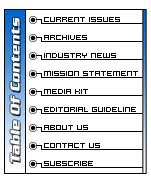Commercial
space-based imagery is revolutionizing how battles are being
planned, rehearsed, and executed by giving savvy military
leaders a common skills unclassified tool that, in almost
real-time, can access data that was previously regarded as
highly classified and hard to disseminate.
Remote
Sensing and the Advent of High-Resolution Satellites
Remote
sensing is the science of collecting Earth data without being in
physical contact with terrain. The data is prepared for use by
geographic information system (GIS) or remote sensing analysts
for use in decision-support tools and 3D fly-through
visualization models. Remote sensing is important to military
operations because often the information needed is of very
large, denied areas where it is not possible to obtain that
information through direct observation either from ground troops
or aerial platforms. The fastest growing segment in the industry
is the high-resolution (one-meter or better) satellites such as
IKONOS, the world's first high-resolution commercial satellite
launched in September 1999, which is owned and operated by Space
Imaging. Other commercial high-resolution systems include
QuickBird, OrbView, and EROS 1-A.
Military
Application of High-Resolution Satellite Data
The
military has traditionally used the discipline of military
intelligence to disseminate low- to medium-resolution commercial
imagery for more than a decade and since then has made major
advances in the speed and range of dissemination. During the
1991 Gulf War, commercial satellite imagery from Landsat was
sent by courier or transmitted over fax machines-often taking
weeks to ingest into military systems. The war in Afghanistan
was the first in which the U.S. government purchased
high-resolution satellite imagery from the private sector and
produced unclassified maps that were distributed and shared with
Coalition forces. For example, high-resolution satellites were
tasked to collect imagery for the U.S. Department of Defense for
both conflicts in Afghanistan and Iraq. During the Iraqi war,
geospatial intelligence was used for communications planning,
mapping, infrastructure assessments, airfield security, and
intelligence support. In one case, commercial imagery was used
to determine soil moisture content that in turn allowed air
defense artillery to know in advance where to safely deploy
heavy equipment. In another case, commercial imagery was used to
produce predictive flood models in case the Iraqi military
destroyed the Qadisiyah Dam near Baghdad.
Now,
the digitization and transmission of data has grown dramatically
and many new battlefield systems and vehicles are being built
with the capability to receive spatial data in support of future
combat systems. High-resolution satellite imagery can be
incorporated to distinguish many different features on the
battlefield and derive information about the battle space such
as maneuver areas and corridors; terrain and cultural features;
borders and buffer zones; airfields, ports and harbors; battle
damage assessment; military vehicle and facilities
classification.
Decreasing
the Future "Fog of War"
The
challenge to future warfare lies in a military leader's ability
to manage this onslaught of information in an age of
transparency when evolving technology instantly affects
decision-making. Strategic planners and commanders will need to
define the terrain where they plan operations, manage all of the
data source information, and establish a flexible, yet
interconnected system with space-based imagery as the backbone
of their geospatial intelligence. Understanding the benefits of
space-based commercial imagery will improve the accuracy and
timeliness of their decisions and reduce the "fog of
war." If leaders can better visualize the battle space they
can incorporate and efficiently distribute the information in
mission rehearsals and change their future fighting strategies.
The goal is to see and understand first, and then act decisively
to defeat the enemy. However, this will only occur if military
leaders learn to adopt the use of space-based imagery as a
common skill just as they have incorporated the use of GPS into
map reading, the cell phone into C2, and night vision devices
into training programs faster than the enemy can.


